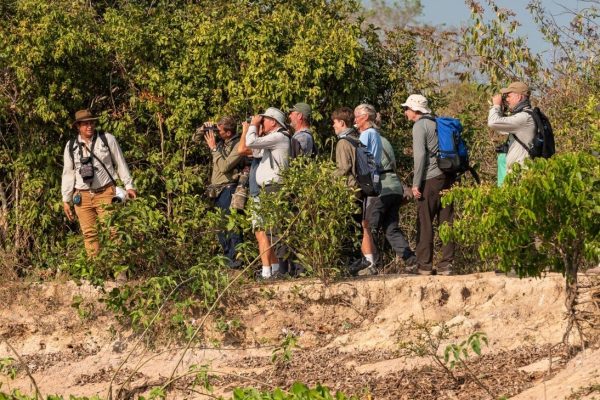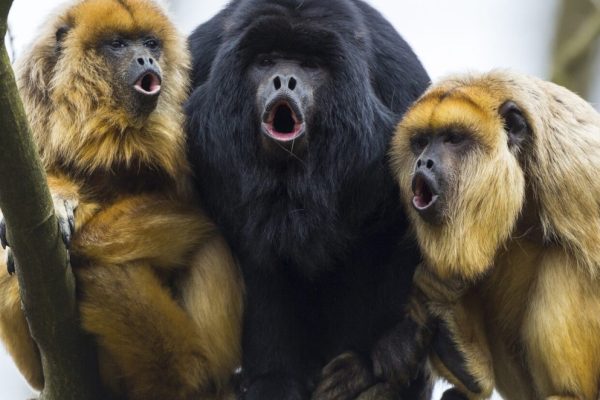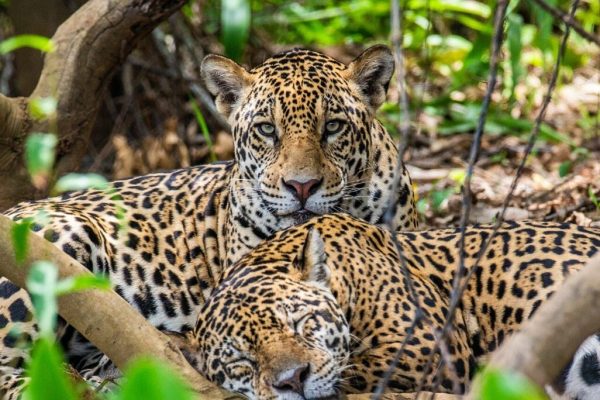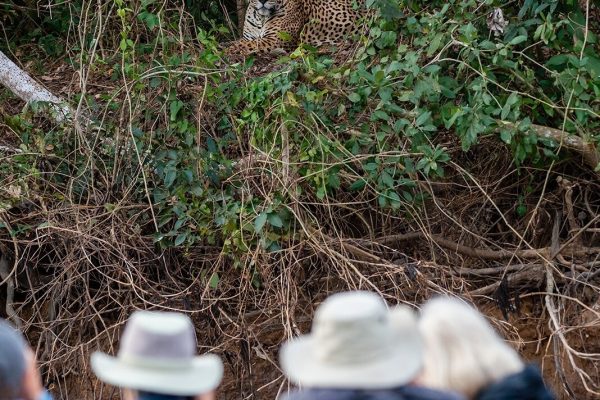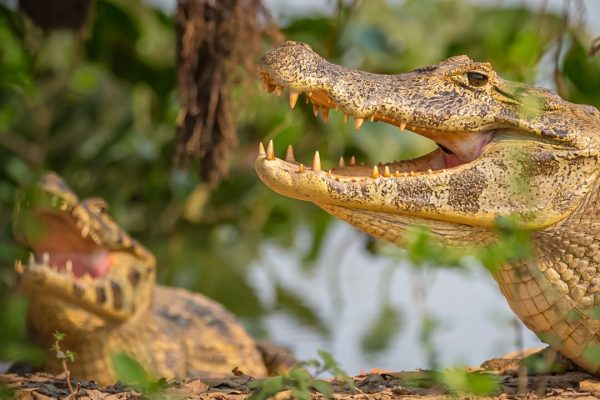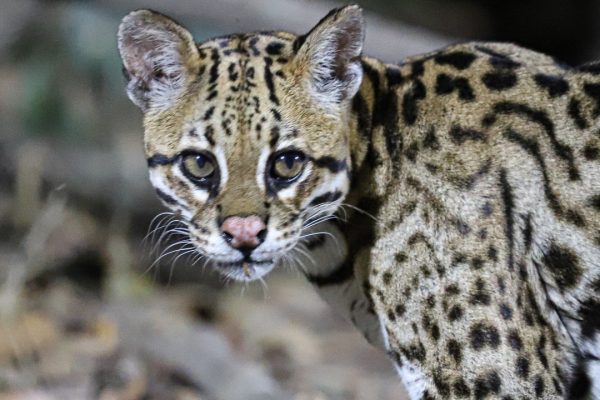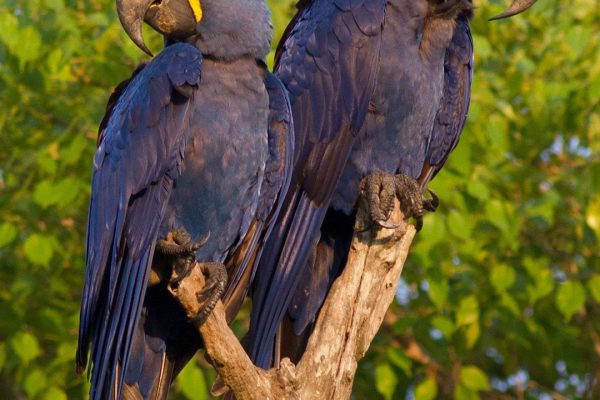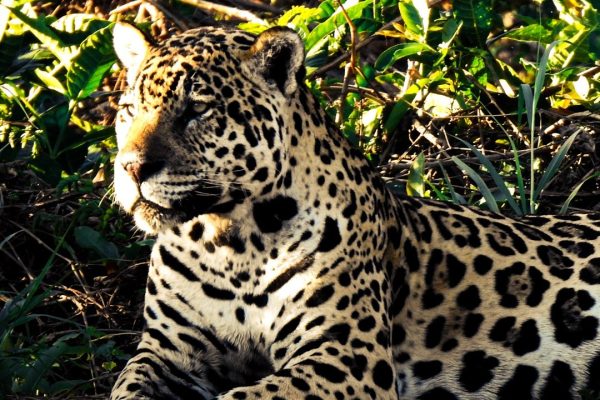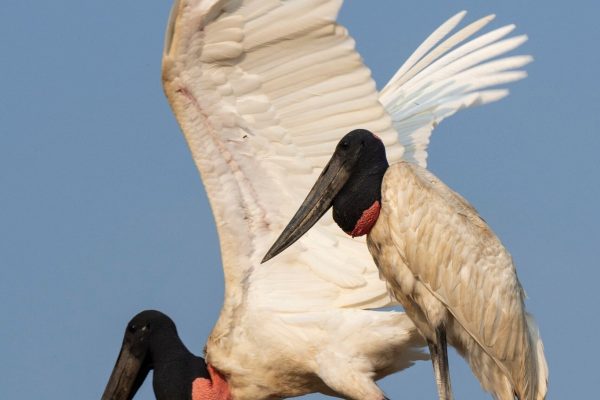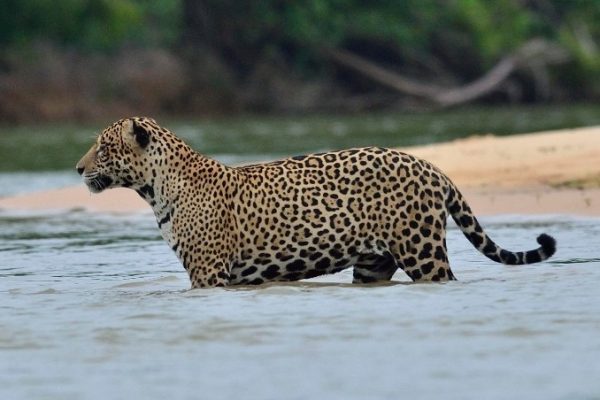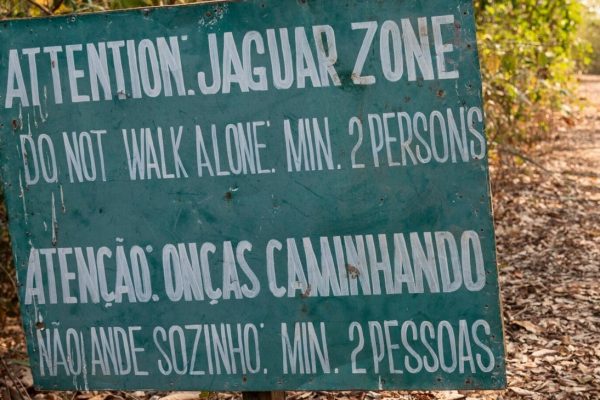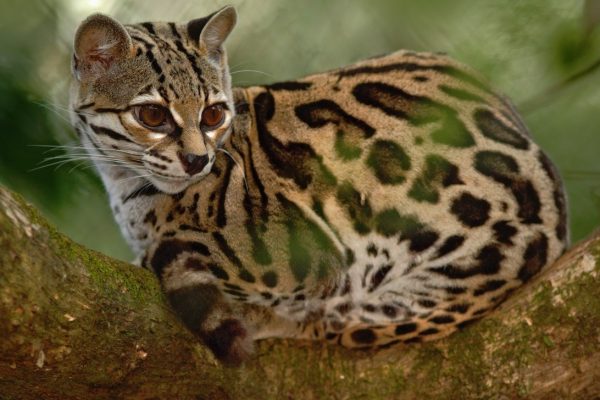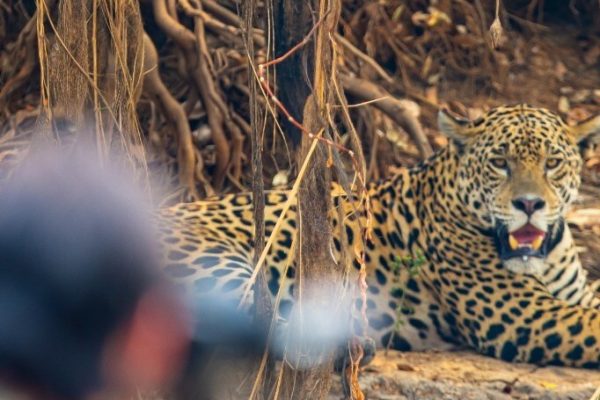Jaguar Extreme Species List
A total of 152 mammals, 405 birds, 127 reptiles, 47 amphibians, 269 fish, and thousands of invertebrate species have been recorded in the Pantanal.
We feature some common and attractive species below, while also providing the best opportunities to observe rarer, shyer, or harder-to-photograph wildlife, including:
-
Jaguar
-
Ocelot
-
Jabiru Stork
-
Agami Heron
| Category |
Featured Rare & Not Easy at All |
| Mammals |
- Jaguar (Jaguar Guarantee)
- Giant River Otter*
- Black & Gold Howler Monkey
- Capybara
- Ocelot
- Brown Capuchin Monkey
- Lesser Bulldog Bat
- Brazilian Tapir
- Puma
- Giant Anteater
- Lesser Anteater
- Maned Wolf
|
| Birds* |
- Hyacinth Macaw
- Jabiru (nest and young)
- Black-Collared Hawk
- Ringed Kingfisher
- Muscovy Duck
- Sungrebe
- Bare-faced Curassow
- Monk Parakeet
- Egrets (Great, Cattle, Snowy)
- Greater Rhea
- Sunbittern
- Agami Heron
- Great Potoo
- American Pygmy Kingfisher
- Green-and-Rufous Kingfisher
- Green Kingfisher
- Amazon Kingfisher
- Toco Toucan
- Scarlet-headed Blackbird
- Osprey
- Little Blue Heron
- Lineated Woodpecker
- Red-and-Green Macaw
- Blue-and-Gold Macaw
|
| Amphibians & Reptiles |
- Yacare Caiman
- Green Iguana
- Black and White Tegu
- Yellow Anaconda
|
| Fish |
- Red-bellied Piranha
- Small-scaled Pacu
- Catfish
- Reticulated Freshwater Stingray
|
| Invertebrates |
- Termite Mounds
- Rhinoceros Beetle
- Blue Morpho Butterfly
|
Featured: Frequently seen on the Jaguar Extreme. Let us know your target species so we can prioritize spotting them for you.
Rare & Featured: Species that we can guarantee to see with a certain amount of time and in specific locations within the Pantanal. Ask us for probability percentages for your target species.
Rare: Harder-to-see species, but possible with specialized guiding and dedicated effort.
Birds: While this is a Jaguar-focused tour, you will see plenty of birds. For dedicated birding, we recommend adding 1–3 days with a specialized birding guide to maximize your experience. The Jaguar Extreme tour focuses primarily on Jaguars and larger wildlife.
Frequently Asked Questions
Is this tour the one for me?
We design them for what people want. We have families that come with kids, we have high rollers who come for some adrenaline and some wildlife, we have some people who want the best hotels and a lot of wildlife or a little wildlife. Some people are crazy about photography: some people want to photograph everything, some people only want to photograph Jaguars. We like to listen to what people want before we tell them what we suggest. That being said, our whole experience is designed so you have a chance to get amazing photos of what you experience – regardless of the camera you’re shooting with.
How well will I see Jaguars?
Since 2010, 100% of SouthWild Jaguar Extreme groups have seen one or more Jaguars well and in the wild. Since 2017, a group will have an average of 14 sightings of Jaguars while in Jaguarland – at least 3 sightings lasting well over 30 minutes and being within 30-yards of the cat (A distance close enough to capture award-winning photographs and jaw-dropping footage with as small a camera as that on your cell-phone). The first Jaguar “viral videos” were taken by our guests, who captured something that at the time only nature documentary filmmakers and photographers had the time and money to see.
What if I don’t see a Jaguar?
In 2005, SouthWild premiered the “Jaguar Guarantee”, when we first pioneered Jaguar tourism. Despite our perfect record since 2010, the guarantee remains in place and is automatically extended to all of our clients: If you do not see a Jaguar during a 3-night, 4-day stay with SouthWild in Jaguarland, we will refund your trip cost with us. Again, we average more than 2 sightings a day, with most groups experiencing 10-15 Jaguar sightings during their 4 nights in Jaguarland.
How do I convince my family to see Jaguars for our next vacation?
SouthWild’s Pantanal is the New World’s closest experience to an African Wildlife Viewing Safari. You can be sure that your family will be comfortable, intrigued, and entertained. They will like the food, they will have wifi good enough to stream films (if they are so inclined), and they probably will surprise themselves by enjoying watching the biggest, most beautiful predators of Latin America sleep, swim, and hunt within an instagram-story-worthy distance.
What are the physical challenges that I will face on this tour?
The outings themselves do not require much mobility as they take place in boats and vehicles. If you are able to walk up and down a staircase (the flotel is a two-story structure) and climb up and down a small ladder with little assistance, you will be able to enjoy the experience along with your tour group. We can provide additional assistance if climbing a one-story staircase, a ladder, or into a boat will be difficult or unfeasible, however we recommend booking a private departure to ensure the proper support can be put in place to maximize your enjoyment of the Pantanal.
My dietary restrictions/preferences make traveling abroad more challenging…
Our menus are designed to satisfy the most adventurous and also the most conservative palates. Our buffets always consist of a salad-building station, rice and vegan, Brazilian-style beans, vegan and gluten-free lentils, a vegan or vegetarian carbohydrate such as pasta or potato-dish, and one light and one dark meat dish. Additional cuisine will be available for variety, however you can count on us always having an option you like. If none of the above would make you comfortable traveling, please let us know what we can arrange for you to eat during your trip. We accommodate kids going through a French-fries-only phase as well as those with dietary needs that can make traveling a bit complicated.
What kind of camera should I bring?
Whatever you wish to shoot with! Our specialty is creating optimal conditions for everyone (long-lens photographers to cell phone documentarians) to get amazing footage to post, frame, or sell for years after a trip with us.
What animals are guaranteed besides Jaguars?
With enough time and with the flexibility to optimize your trip to get that sighting, we can guarantee a wide range of wildlife species. Jaguar Extreme focuses on Jaguars and the main stars of the Pantanal, so these Jag-oriented, fixed-departure groups are not ideal for those who wish to focus on species other than Jaguars. If you wish to concentrate more on birds or some other star mammals such as Giant Otters, we recommend booking a Private Departure with other like-minded travelers.
What flights should I look at when considering this tour?
You will be flying in and out of Cuiaba’s airport (Marechal Rondon International Airport). Airport Code: CGB. Arrive the night before or by 12PM on the first day of your tour. Depart no earlier from 12PM on the last day of your tour. Late arrival in Fixed Departure will delay the group and may require an additional private transfer fee. The tour departs into the Pantanal at 2PM in order to get to SouthWild Pantanal Lodge in time to try for our signature Ocelot viewing at our 5:50PM Ocelot Experience.
Recommended Pairings for Jaguar Extreme
Jaguar Extreme is just one week of your vacation, so you can easily combine it with more adventure. Take a morning flight from any major Brazilian airport and arrive in Jaguarland by the afternoon on Day 1. On Day 7, return to the airport by midday to catch an afternoon flight for your next Brazilian adventure. Whatever you’re in the mood for next, we have a trip for you.
Not quite what you are looking for? Let us help you craft a customized
experience that achieves your goals.
We can introduce you to partner tribes eager to share and preserve their culture, take you to the heights of luxury and pampering, or guide you deeper into the jungle to disconnect from the world and reconnect with yourself in the heart of nature.
Our Nature
Conservation is not outpacing the destruction of biodiversity;
The only way to counteract this reality before it’s too late is to look beyond individual sector interests and find a compromise that aligns everyone toward a common goal: saving our natural world now.
We’ve been creating cutting-edge methods for forging weapons of mass conservation
We leverage our expertise in evolutionary biology and animal behavior to pioneer responsible, reliable, and effective wildlife experiences. Rare and charismatic umbrella species have the power to “launch a thousand ships” for the conservation of their habitats.
Specializes in taking people in comfort to the finest transformative wildlife experiences,
We guarantee high-quality wildlife encounters with rare and remarkable species in stunning natural habitats. Each year, we refine our travel and wildlife experiences to remain the top choice for naturalist travelers, luxury safari operators, birders, photographers, and professional wildlife filmmakers.
Our Origin Story
In 1977, a young biologist from Princeton was studying mixed-species bird flocks in the newly established Manu National Park in the Peruvian Amazon. During his master’s research at Oxford, he learned of a devastating government plan to kill all animals in the 600,000-acre Manu Reserved Zone next to the park. The plan involved capturing monkeys for biomedical labs and killing fish, caimans, and peccaries for meat and skins.
A lifelong advocate for animals, he petitioned the government to try non-consumptive use before resorting to slaughter. Having visited another remote Amazonian reserve that, despite poor wildlife viewing, attracted tourists, he realized that building a lodge in the Manu Reserved Zone—which had far more wildlife—could prevent the planned slaughter through ecotourism.
He surveyed every lake in the park and reserved zone, confirming the area’s superior ecotourism potential, and repeatedly presented reports to the national park service in Lima. Eventually, the park service agreed to try tourism instead of the kill-and-capture plan. To ensure success, the biologist took a young hotelier from Cusco into the Reserved Zone to show him the wildlife and suggest a lodge location. The idea: if you build it, they will come.
The biologist even lent the hotelier funds to build the first lodge. Though primitive and far from civilization, it succeeded—the lodge owner repaid the loan, and other lodges soon followed. Tourism flourished, and the original plan to harvest animals was abandoned. By the 1990s, the entire Reserved Zone was incorporated into the park.
Despite the remoteness of Manu, tourism thrived because visitors encountered abundant wildlife, making the journey worthwhile. Through his surveys, reports, and persistence, the 25-year-old biologist prevented the hunting and trapping of 600,000 acres of wildlife while expanding the national park. His success proved that, with data and determination, it was possible to protect wildlife from destruction.
Jaguars: Weapons of Mass Conservation
The Jaguar (Panthera onca) is the largest cat in the Americas. Resembling the Leopard of Africa and Asia, it sports black and brown rosettes scattered over a pale gold coat. Built for power rather than endurance, this muscular predator has a large head, round belly, and robust build.
Unlike other large cats, the Jaguar does not aim for the jugular to kill its prey. Instead, it uses its powerful jaws to pierce the back of skulls in a single bite, paralyzing and killing surprisingly large prey. While Tigers and Lions have a stronger absolute bite, the Jaguar has the most powerful bite relative to its body size. Wielding the strongest bite per pound of any cat, growing as large as a female Lion, and sitting atop the food chain, the Jaguar is the undisputed king of the New World jungle.
Its beauty and dominance make the Jaguar a vital umbrella species: conserving it protects thousands of other species within its habitat, which spans landscapes, countries, and continents. The Pantanal, a Florida-sized wetland savannah in the Brazilian states of Mato Grosso and Mato Grosso do Sul, offers the perfect environment to witness this majestic cat. Large undisturbed swaths of habitat remain thanks to annual floods and legal protections at both state and federal levels.
However, Mato Grosso is Brazil’s fastest-growing agricultural producer. As of 2020, it led the country in cattle, soy, cotton, and corn production. These commodities, along with logging, are responsible for the destruction of Jaguar habitats and the killing of big cats. Despite laws banning illegal forest destruction and Jaguar hunting, enforcement is weak, and patrolling is minimal in remote areas.
Recognizing the potential of wildlife tourism, pioneered Jaguar tourism to shift the focus from habitat destruction to conservation. In 2004, founder established the world’s first “Jaguar Guarantee” in the Pantanal—an important step in using this umbrella species to protect wild habitats.
Creating Jaguarland
Since the 1970s, our founder dreamed of leveraging Jaguar viewing to drive conservation. However, the elusive cat had always been impossible to guarantee due to its total fear of humans. The dream came closer to reality when rumors surfaced of semi-habituated Jaguars spotted just two hours from the which at that time focused primarily on Giant Otters.
These Jaguars had reportedly lost much of their fear of humans in motorboats because of the frequent presence of sport fishermen who did not carry guns. Some fishermen even tossed fish to the big cats for amusement. This specific group of Jaguars seemed unafraid of motorboats, creating a unique opportunity for responsible wildlife tourism.
Financed biologists to patrol the riverbanks and collect data on the frequency and location of Jaguar sightings. The observations and photographs of a few individual Jaguars proved that Jaguar tourism could succeed.
To protect the habitat, purchased 3,025 hectares (7,475 acres) of critical Jaguar land and negotiated agreements with neighboring ranchers to prevent Jaguar killings. Over time, built mutual trust with the Jaguars by carefully observing them without harm.
Once the Jaguars lost their fear of boats, Jaguar tourism began to thrive, encouraging the local community to follow suit. Today, Jaguar tourism and conservation dominate the area. Illegal Jaguar hunting has become culturally unacceptable, and ecotourism now surpasses sports fishing in popularity in that region of the Pantanal. Sport fishing live-aboard ships even welcome the Jaguars, as they can pivot to ecotourism during months better suited for Jaguar viewing than fishing.
The approximately 85 Jaguars living in Jaguarland have proven to be true Weapons of Mass Conservation.
These days, we are thrilled to witness Jaguar sightings becoming more frequent, longer in duration, and richer in observed behavior compared to the first 18 years of our Jaguarland protection, observation, and habituation efforts.
We are confident that these incredible Jaguar encounters are not a matter of luck. They are the result of years of dedicated investment in protecting, habituating, and empowering the Jaguar.
Jaguarland Creation Timeline
Setting the stage for a wildlife miracle
1937
First national park is created in Brazil: Itatiaia National Park of Brazil.
1967
Brazil outlaws all wildlife hunting. Sport-fishing is now the main legal outdoor recreational activity involving wildlife.
1975
The Jaguar is listed under the Convention on International Trade in Endangered Species (CITES) Appendix I, thus banning all international trade in Jaguars or their parts.
1981
First national Brazilian Policy on environmental regulation and protection (Law no. 6.938/81).
1988
New Brazilian constitution further embraces environmental regulations and protections.
2000-2004
Sports-fishing draws thousands of fishermen to the 100-km of river channels upstream from Porto Jofre, accidentally habituating Jaguars to motorboats. Some fishermen are hired to try to show people Jaguars. Low sighting rates of Jaguars and effort needed to achieve a sighting makes it hard to draw significant interest in Jaguar viewing.
Jaguarland Project Begins
2004
SouthWild discovers the “miracle of tame Jaguars; the first biologists are dispatched to collect data on the visibility and location of Jaguars. Mato Grosso and local ranchers established the Meeting of the Waters State Park just north of Porto Jofre.
2005
SouthWild purchases 7,474+ acres of privately-owned land inside this new state park and creates the “Jaguar Research Center”. Brazil experiences the most extensive Amazon forest destruction in its history. Local people in Pantanal still are worried that habituated Jaguars might be dangerous or might kill too many of their cows.
2005
SouthWild announces first ever “Jaguar Guarantee”: spend 4 days with SouthWild and see a Jaguar, and if you do not see a cat you get a $1000 refund or credit to come again within the next two years. The chance of seeing a Jaguar is 75% per day.
2010
International conservation groups invest over $10,000,000 in Jaguar conservation in that part of the Pantanal, namely “Jaguarland”. This investment is the direct result of SouthWild spending years introducing major philanthropists to the area, taking them on trips through “Jaguarland” to show them this wildlife miracle. A number of Brazilian tour operators emulate SouthWild by starting to operate their own, simpler Jaguar tourism, and this green industry picks up steam.
Jaguarland Viewing Success
2011
SouthWild achieves 100% success in its Jaguar Tours: every SouthWild guest saw a Jaguar well. Local attitudes about Jaguars begin to improve, and more tour operators are on rivers sharing viewings of Jaguars. Jaguar tour operators rally to protest the pointless killing of a famous Jaguarland Jaguar, who is found dead on the shores of Panthera’s São Bento Reserve. SouthWild positively identifies the slain Jaguar and provides information on where it normally was seen. The police come and raise a stink when they go to the part of the Pantanal where the presumed Jag killer lives. Since that date, no more Jaguarland Jaguars have been killed by humans.
2015
Jaguar tour operators agree to cooperate with each other to establish best practices for Jaguar viewing to ensure visitor safety and best Jaguar viewing.
2017
Jaguar Boom! Resident Jaguars increase significantly in numbers. SouthWild’s Jaguar Dossier now boasts over 100 individual cats. Average daily sightings are well over 2 per day.
2020
Wildfires engulf the Pantanal and Jaguarland. Local tour operators and Jaguar conservation groups all offer critical first-response to the fires, raise the alarm, and fundraise to save local wildlife. The fires make the front page of the New York Times.

